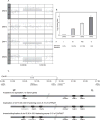Ordered subset analysis of copy number variation association with age at onset of Alzheimer's disease
- PMID: 24787912
- PMCID: PMC4866488
- DOI: 10.3233/JAD-132693
Ordered subset analysis of copy number variation association with age at onset of Alzheimer's disease
Abstract
Genetic heterogeneity is a common problem for genome-wide association studies of complex human diseases. Ordered-subset analysis (OSA) reduces genetic heterogeneity and optimizes the use of phenotypic information, thus improving power under some disease models. We hypothesized that in a genetically heterogeneous disorder such as Alzheimer's disease (AD), utilizing OSA by age at onset (AAO) of AD may increase the power to detect relevant loci. Using this approach, 8 loci were detected, including the chr15 : 30,44 region harboring CHRFAM7A. The association was replicated in the NIA-LOAD Familial Study dataset. CHRFAM7A is a dominant negative regulator of CHRNA7 function, the receptor that facilitates amyloid-β1-42 internalization through endocytosis and has been implicated in AD. OSA, using AAO as a quantitative trait, optimized power and detected replicable signals suggesting that AD is genetically heterogeneous between AAO subsets.
Keywords: Age at onset; Alzheimer's disease; copy number variation.
Figures


References
-
- Ebly EM, Parhad IM, Hogan DB, Fung TS. Prevalence and types of dementia in the very old: Results from the Canadian Study of Health and Aging. Neurology. 1994;44:1593–1600. - PubMed
-
- Kukull WA, Higdon R, Bowen JD, McCormick WC, Teri L, Schellenberg GD, van Belle G, Jolley L, Larson EB. Dementia and Alzheimer disease incidence: A prospective cohort study. Arch Neurol. 2002;59:1737–1746. - PubMed
-
- Rocca WA, Hofman A, Brayne C, Breteler MM, Clarke M, Copeland JR, Dartigues JF, Engedal K, Hagnell O, Heeren TJ, et al. Frequency and distribution of Alzheimer’s disease in Europe: A collaborative study of 1980–1990 prevalence findings. The EURODEM-Prevalence Research Group. Ann Neurol. 1991;30:381–390. - PubMed
Publication types
MeSH terms
Substances
Grants and funding
LinkOut - more resources
Full Text Sources
Other Literature Sources
Medical

